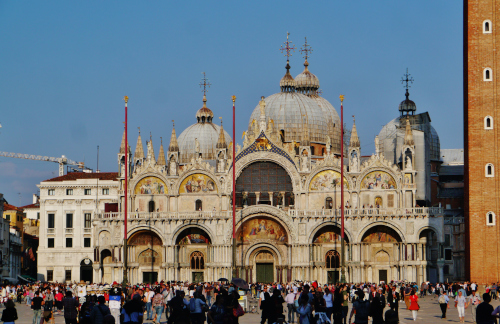ST MARK'S BASILICA
VENICE
The Golden Church, this is the sobriquet for the St Mark's basilica. This is due to the mosaic decorations entirely set against a gold background of about eight thousand square metres, which covers the domes, vaults, lunettes and arches, leaving aside only the floor and the lower parts of the load-bearing walls. Millions and millions of tesserae – just how many, it is impossible to know – have been placed side by side to narrate the episodes of the Old and New Testaments, from the Creation to the coming of Christ and Judgment Day, not to forget the stories of St Mark and other saints. Yet all this magnificence is due to a single material: glass. The polychrome tesserae are obtained from glass sheets, cut into hundreds of pieces, while those of gold consist of two layers of transparent glass enclosing a thin sheet of gold known as gold leaf.

The facade of St Mark's Basilica
The first mosaics encountered are those in the atrium. Although they recount Old Testament passages from Genesis and Exodus, they are about a hundred years later than those of the naves and domes. Indeed, they date back to the 13th century and are the work of Venetian craftsmen. The pictorial story starts from the small Creation dome, on the north side, consisting of three concentric rings. The first two see God intent on giving life to creation and the first man, then resting on the seventh day; while the third begins with the birth of Eve from Adam's rib, and ends with the two progenitors being driven from the Earthly Paradise, following original sin. The stories taken from the book of Genesis then proceed along the lunettes and arches with the vicissitudes of Cain and Abel, of Noah and of the Universal Flood, and with the building of the Tower of Babel. Following on towards the left arm of the atrium are five more small domes, whose scenes are distributed along a single band: one entirely dedicated to the stories of Abraham, as many as three to Joseph, Jacob's favourite son, betrayed by his brothers, who in Egypt will become the Pharaoh's adviser thanks to his ability to interpret dreams, and the last one reserved for Moses, who will lead the Jews to the Promised Land, as told in the Book of Exodus.
Having passed through the atrium, it is a good idea to head towards the presbyterial area, oriented towards the rising of the sun. Indeed, the 12th-century mosaic decoration, the work of Byzantine mosaicists, unfolds from east to west, and is entirely dedicated to the New Testament. Looking up, one sees the first dome, named after Emmanuel or the prophets. In the centre, on a starry sky, Christ stands out. All around the prophets are holding a scroll with the prediction of His coming; among them, the Virgin is also present, thanks to whom the Word became flesh. The salient episodies in the life of Jesus, which proceed from the Annunciation to the Descent into the Underworld, called Anastasis, and to the Resurrection, are distributed among the vaults that enclose the second dome, the central one, known as the dome of the Ascension. Here, Christ, seated on a rainbow, is being accompanied by four angels to heaven. Below, among slender trees whose branches extend upwards, the twelve apostles, together with Mary and two angels, gaze after him. The third dome sees the Holy Spirit as its protagonist, in the form of a dove placed on a throne. Rays of light emanate from it, ending in tongues of fire over the heads of the apostles: it is the Pentecost dome. The itinerary ends with the two vaults dedicated to Paradise and the Apocalypse